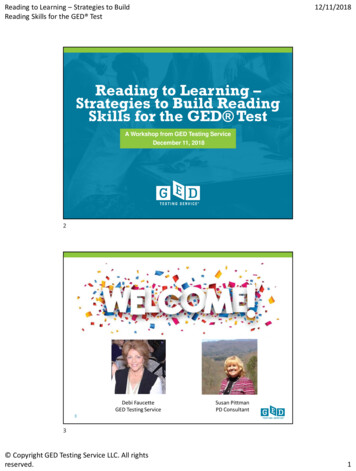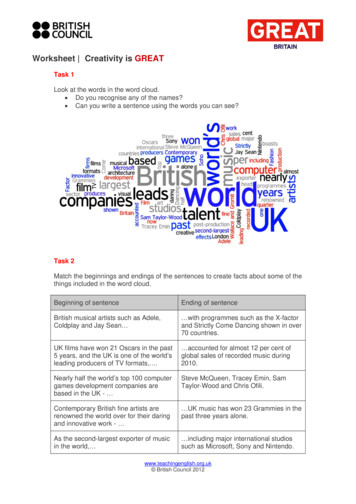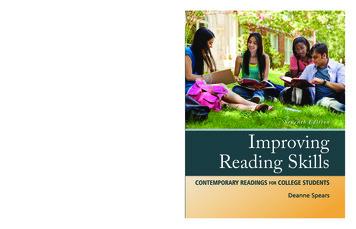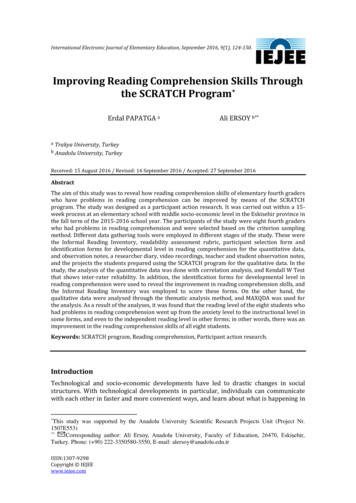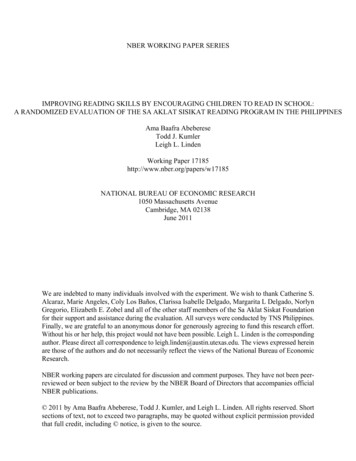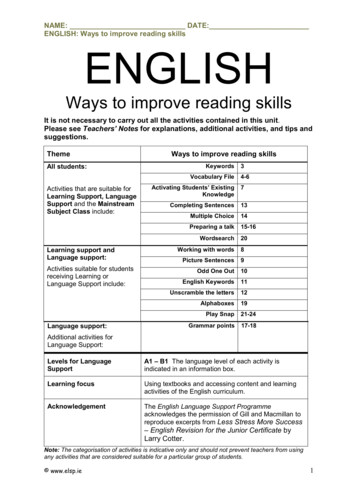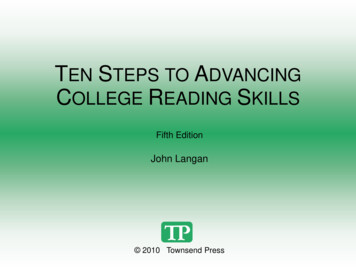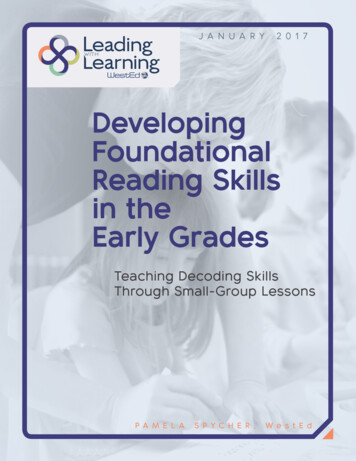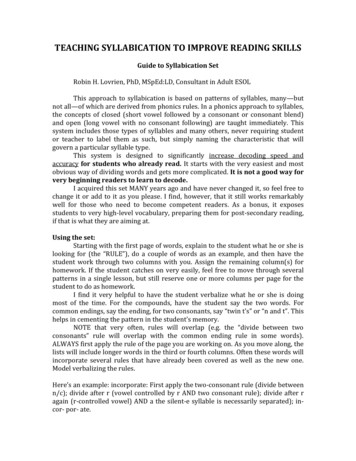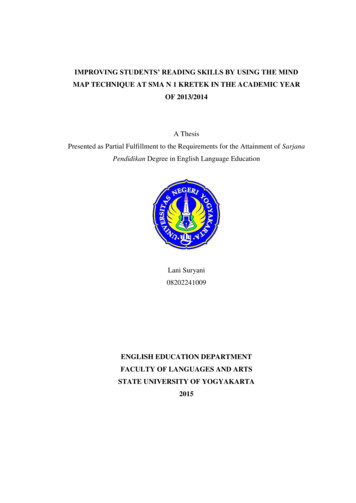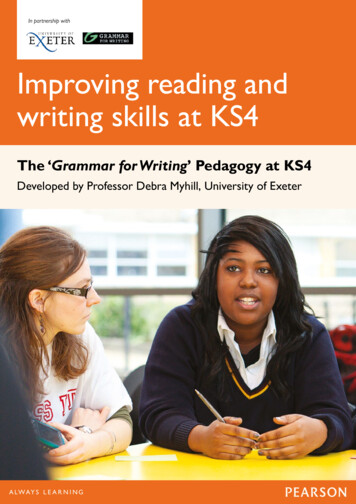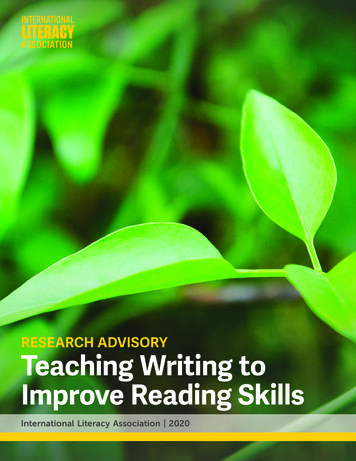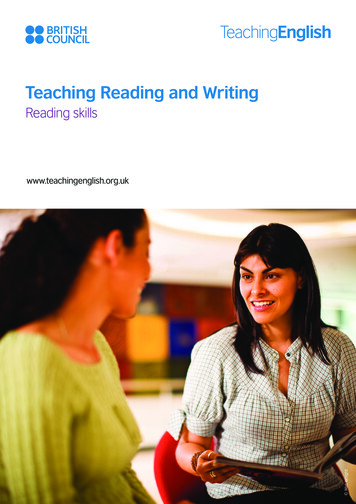
Transcription
Teaching Reading and WritingReading skills Mat Wrightwww.teachingenglish.org.uk
Teaching Reading and WritingReading skillsLearning outcomesThis module focuses on teaching reading and equipping learners with the skills of reading. By the end of themodule you will be able to: recognise a range of skills for effective reading identify activities that can be used to practise these specific skills explore other techniques for improving reading skills.1 Before you watcha. What skills do you need for effective reading?Think about when you read in your own language and also in English?Try to compare your answers with a partner.b. Do you know what these reading skills are?inferringskimmingscanningMatch each one to the definitions taken from the British Council’s TKT Glossary.is reading a text quickly to pick out specific information.is reading a text quickly to get a general idea of what it is about.is deciding how a writer feels about something from the way that they writerather than the words they use.TeachingEnglish British Council 20152
Teaching Reading and WritingReading skills2 Watch2.1 Reading skills adviceWatch and listen to the commentary at the beginning of Reading skills: Part 1 (00:00 to 01:06).Then pause the video and answer the following questions.a. What reading skills does the trainer mention? b. Finish the following sentences according to the trainer’s advice.“The reason that we read affects .”“We need to work with our students to . .”“We also need to show them .”“We also need to ask comprehension questions and conduct activities that. .”2.2 Reading skills practiceWhat does this advice mean in practice? Complete the following reading activity and afterwards we willanalyse the reading skills that you used.a. On the following page is a reading text about learning styles. Don’t read it yet, instead make a note belowabout what you know about learning styles.b. Look quickly (25 seconds maximum) at the reading text on the next page. What is it about?c. Quickly look again at the reading text on the next page. Which three learning styles are mentioned?1.2.3.TeachingEnglish British Council 20153
Teaching Reading and WritingReading skillsLearning stylesWe all learn in different ways. One theory of learning focuses on the way information isgiven to learners and refers to visual, auditory and kinaesthetic learners. Visual learners respond well to pictures, colours, images. They need to see things tohelp them learn and remember. Auditory learners learn best by hearing things. Kinaesthetic learners like movement. They need movement and hands-on tasks tohelp them learn.In any class we teach, the learners will have a range of learning styles. This means thatto help all of our learners learn we have to use a range of classroom activities andtechniques so that different styles of learner are interested and can learn from ourlessons.Adapted from: British Council (2008), Teaching SpeakingRead the text in more detail and answer the following questions. The first one has been done as an example.d. Who is the text written for and how do you know that?The text is written for teachers. It says we teach, our class and our lesson as well asusing teaching jargon such as activities and techniques.e. What do you think the expression ‘hands-on’ means? What helped you to guess?f. In the final sentence what does ‘this’ refer to?g. Is the theory outlined commonly accepted as the main theory of learning styles? Does the writer consider itthe main theory? Please give reasons for your answer.h. What is the main point that the writer wants to convey? How do you know that?TeachingEnglish British Council 20154
Teaching Reading and WritingReading skillsi. This is the first part of a text on learning styles. What do you think second part will be about?Try to compare your answers with a partner and then check them with the answer section at the end.2.3 Reading skills analysis1. We are now going to look at the questions again and think about their purpose. Each one practised one of thereading skills listed in the box below. Match each reading skill to each question. The first one has been donefor you as an example.scanninginferringpredictingrecognising linksestablishing context for readingguessing meaning from contextidentifying the target audienceskimmingidentifying the main messageQuestiona. On the following page is a reading text about learning styles. Don’t readit yet, instead make a note about what you know about learning styles.Reading skillestablishing context forreadingb. Look quickly (25 seconds maximum) at the reading text on the nextpage. What is it about?c. Quickly look again at the reading text on the next page. Which threelearning styles are mentioned?d. Who is the text written for and how do you know that?e. What do you think the expression ‘hands-on’ means? What helped youto guess?f. In the final sentence what does ‘this’ refer to?g. Is the theory outlined commonly accepted as the main theory oflearning styles? Does the writer consider it the main theory? Pleasegive reasons for your answer.h. What is the main point that the writer wants to convey? How do youknow that?i. This is the first part of a text on learning styles. What do you thinksecond part will be about?TeachingEnglish British Council 20155
Teaching Reading and WritingReading skills2.4 Practising reading skillsa. Watch the next sequence of Reading skills: Part 1 (01:22 to 08:24). You will see specific reading skillsbeing practised. Put the activities below in the order you see them.Scanning a text for specific details.Guessing the meaning of words from the context.Predicting the content of a text.Skimming a text for the main ideas.Identifying a text type and the purpose for reading.Establishing the context for a reading text.b. Watch and listen again. How does the teacher in sequence four (04:47 to 05:33) cater for different learningstyles?2.5 Teaching reading skillsa. Watch the final sequence of Reading skills: Part 1 (08:39 to 10:57). The teachers talk about how theyteach and provide practise for reading skills. Which of their tips have you seen in the video? b. What other tips and techniques do they mention? c. Which tips and techniques could you use with your classes? Put a tick ( ) in the right hand column of eachtable.TeachingEnglish British Council 20156
Teaching Reading and WritingReading skills2.6 Reading skills – further practicea. Watch Reading skills: Part 2 (00:00 to 16:03).What activities does the teacher use to practise each reading skill? Complete the table.Reading skillActivity1. Establishing the context of the reading text.(00:24 to 02:30)2. Predicting the content.(02:31 to 04:30)3. Skimming for main ideas.(04:30 to 07:20)4. Scanning for specific details.(07:20 to 09:22)5. Guessing the meaning of vocabulary fromthe context (09:22 to 16:03)TeachingEnglish British Council 20157
Teaching Reading and WritingReading skills3 ReflectionThink about the next few classes that you are going to teach. If you use a coursebook, look at the nextreading text.a. Analyse the reading tasks through the following questions:1.Are there tasks for learners before, during and after reading?2.Are there are a range of tasks that appeal to different learning styles?3.What reading skills do the tasks practise?4.How can you make these skills explicit to learners and help them identify how to improve their skills?b. How could you adapt and/or supplement the tasks to match your learners’ needs? Are there any techniquesfrom this module that you could use and try out?TeachingEnglish British Council 20158
Transcripts and answers
Teaching Reading and WritingReading skillsTranscripts of trainer’s talk2.1 Reading skills adviceThe reason that we read affects how we read so for example if we are following instructions we willread differently than if we are reading to find out information.There are a number of skills involved in reading for example predicting, skimming, scanning andrecognising links. We need to work with our students to analyse what these skills are and also to showthem how they can get better at these skills. We also need to ask comprehension questions andconduct activities that will practise these specific skills.Now let’s look at some examples of activities that practise a range of reading skills. Watch the films andmake notes to answer the questions in the viewing task. The answers will appear at the end of thesequence.2.5 Teaching reading skillsLet’s listen now to some tips. Watch the interviews and make notes to answer the questions in theviewing task. The answers will appear at the end of the section.In the next stage students read the text again, this time scanning for details. The teacher writesnumbers on the board and asks students to find their significance in the text.This activity encourages students to scan the text for specific information, allowing them to gain morein-depth understanding of the topic.10TeachingEnglish British Council 2015
Teaching Reading and WritingReading skills2.6 Reading skills – further practiceIn this lesson you’ll see how a range of reading skills is practised in one reading lesson. Watch the filmsand make notes to answer the questions in the viewing task. The answers will appear at the end of thesequence.In this lesson, the students are going to look at a short article about social networking sites, Facebookand Twitter.The teacher starts the lesson by showing students the Facebook logo and asking questions.This generates interest and starts students thinking about the theme of the reading task to come.First of all, students do a short punctuation task, using a sentence from the reading text.Now the teacher uses the sentence to encourage students to predict the content of the text.If students predict some of the content of a text before reading it, they can then read to check if theirpredictions are correct. This gives them a purpose for reading.This kind of purpose is motivating for students because it has been generated by them; they haveproduced the predictions themselves.Now the teacher asks students to read through the text quickly to check their predictions. She uses thistask to encourage the students to skim the text – to read it quickly to get the main ideas. The skimmingactivity introduces students to the article and helps them gain a sense of what it is about, withoutputting them under pressure to read and understand the whole text in one go.When students approach the text in stages, it makes the task more manageable and therefore moremotivating.In the next stage students read the text again, this time scanning for details. The teacher writesnumbers on the board and asks students to find their significance in the text.This activity encourages students to scan the text for specific information, allowing them to gain morein-depth understanding of the topic.In the last stage, the students are encouraged to deduce meaning from context. The teacher gives thelearners a worksheet with questions about the text content and the meaning of some vocabulary items.The students read the text again to answer the questions. No dictionaries are allowed! They mustanswer the questions and guess the meaning of the unfamiliar vocabulary from the other words andsentences that surround it.An activity like this encourages students to be independent learners because it teaches them to lookfor clues in the text to deduce meaning, and not rely on dictionaries or the teacher!11TeachingEnglish British Council 2015
Teaching Reading and WritingReading skillsAnswers1 Before you watchb. DefinitionsScanningis reading a text quickly to pick out specific information.Skimmingis reading a text quickly to get a general idea of what it is about.Inferringis deciding how a writer feels about something from the way that they write rather thanthe words they use.2.1 Reading skills practicea. The trainer mentions the following skills: predicting skimming scanning recognising linksb. Trainer advice.“The reason that we read affects how we read.”“We need to work with our students to analyse what these skills are.”“We also need to show them how they can get better at these skills.”“We also need to ask comprehension questions and conduct activities that will practise these specificskills.”2.2 Reading skills practiceb. Look quickly (25 seconds maximum) at the reading text on the next page. What is it about?Learning stylesc. Quickly look again at the reading text on the next page. Which three learning styles are mentioned?1. visual2. auditory3. kinaestheticd. Who is the text written for and how do you know that?The text is written for teachers. It says we teach, our class and our lesson as well as using teachingjargon such as activities and techniques.e. What do you think the expression ‘hands-on’ means? What helped you to guess?Practical – from movement. You can guess from what the other two styles don’t cover and from the wordhand.12TeachingEnglish British Council 2015
Teaching Reading and WritingReading skillsf. In the final sentence what does ‘this’ refer to?The previous sentence.g. Is the theory outlined commonly accepted as the main theory of learning styles? Does the writer consider itthe main theory? Please give reasons for your answer.Yes as the writer does not mention any other theory and is able to apply this theory to teachers’practice.h. What is the main point that the writer wants to convey? How do you know that?To reach all our learners we have to use a range of learning styles. We know this because the lastsentence summarises what has gone before and starts with this means. Another reason is that becausethe target audience are teachers, this is how the topic of learning styles relates to them.i. This is the first part of a text on learning styles. What do you think second part will be about?Different tasks and techniques that we can use to reach all our learners.2.3 Reading skills analysis1. Reading skillsQuestionReading skilla. On the following page is a reading text about learning styles. Don’t read establishing context forit yet, instead make a note about what you know about learning styles. readingb. Look quickly (25 seconds maximum) at the reading text on the nextpage. What is it about?skimmingc. Quickly look again at the reading text on the next page. Which threelearning styles are mentioned?scanningd. Who is the text written for and how do you know that?identifying the targetaudiencee. What do you think the expression ‘hands-on’ means? What helped youto guess?guessing meaning fromcontextf. In the final sentence what does ‘this’ refer to?recognising linksg. Is the theory outlined commonly accepted as the main theory oflearning styles? Does the writer consider it the main theory? Pleasegive reasons for your answer.inferringh. What is the main point that the writer wants to convey? How do youknow that?identifying the mainmessagei. This is the first part of a text on learning styles. What do you thinksecond part will be about?predicting2. Giving reasons to support answers.Giving a reason as part of each answer offers additional information about how reading skills are applied.As teachers you can use this technique to help understand how your learners reach their answers andtherefore ascertain their needsTeachingEnglish British Council 201513
Teaching Reading and WritingReading skills2.4 Practising reading skillsa. Reading skills practice.2.Scanning a text for specific details.5.Guessing the meaning of words from the context.1.Predicting the content of a text.6.Skimming a text for the main ideas.3.Identifying a text type and the purpose for reading.4.Establishing the context for a reading text.b. Catering for different learning styles.The teacher caters for visual learners by showing the class pictures. The use of a mnemonic may alsohelp learners who find it difficult to remember a lot of information.2.5 Teaching reading skillsa. Teaching tips. Use visual aids to establish context and generate interest Teach learners to predict text content Teach learners to skim the text for the main ideas Teach learners to scan the text for specific details Teach learners to understand meaning from contextb. Other tips and techniques mentioned Pre-teach key vocabulary Help learners to understand that they don’t need to know the meaning of every new word in the text Give learners explanations about reading skills terminology, for example prediction and skimming intheir first languageTeachingEnglish British Council 201514
Teaching Reading and WritingReading skills2.6 Reading skills – further practiceReading skillActivity1. Establishing the context of the reading text.(00:24 to 02:30)The teacher uses visual images (social networklogos) to establish the text context.2. Predicting the content.(02:31 to 04:30)Learners punctuate a sentence from the text,then use that sentence to predict the textcontent.3. Skimming for main ideas.(04:30 to 07:20)Learners skim the text to check if theirpredictions (from the previous stage) are correct.4. Scanning for specific details.(07:20 to 09:22)Learners scan the text to find the significance ofspecific numbers.5. Guessing the meaning of vocabulary fromthe context (09:22 to 16:03)Learners answer worksheet questions about themeaning of some text vocabulary. They cannot usedictionaries and must deduce the meaning fromthe words that surround the target vocabulary.TeachingEnglish British Council 201515
AcknowledgementsSession notes developed by Marianne Tudor-CraigVideo produced by Jane BoylanWith thanks to the following ELT practitioners and their classes, for their contribution to the video footage.Gladys Fanyn Yeh (Taiwan)Prossy Arinaitwe (Rwanda)Maria Veronica Di Bin (Argentina)Awgichew Arega Abebe (Ethiopia)Evelin Amada Ojeda Naveda (Venezuela) British Council 2015 / E021The British Council is the United Kingdom’s international organisation for cultural relations and educational opportunities.
This module focuses on teaching reading and equipping learners with the skills of reading. By the end of the module you will be able to: recognise a range of skills for effective reading identify activities that can be used to practise these specific skills explore other techniques for
